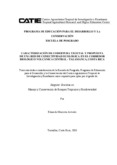| dc.contributor.advisor | Finegan, B. | |
| dc.contributor.author | Murrieta Arévalo, E. | |
| dc.contributor.other | CATIE - Centro Agronómico Tropical de Investigación y Enseñanza | |
| dc.date.accessioned | 2014-10-17T06:35:27Z | |
| dc.date.available | 2014-10-17T06:35:27Z | |
| dc.date.issued | 2006 | es_ES |
| dc.identifier | 367946 | es_ES |
| dc.identifier.uri | https://repositorio.catie.ac.cr/handle/11554/772 | |
| dc.description | Tesis (Mag.Sc.) - CATIE, Turrialba (Costa Rica) 2006 | es_ES |
| dc.description.abstract | En este trabajo se realiza un estudio sobre identificación y caracterización de los tipos de bosques naturales para una propuesta de red de conectividad estructural ecológica en el Corredor Biológico Volcánica Central-Talamanca. Estos bosques, fueron caracterizados y comparados en cuanto a variables como composición, estructura, riqueza y diversidad florística. La distribución de los tipos de bosques se ligó principalmente a cambios altitudinales. Fue posible así elaborar un mapa preliminar de tipos de bosque en función a la variable altitud. Con aplicación SIG se desarrollaron cinco escenarios de redes de conectividad estructural ecológica, tomando en cuenta las rutas de conexión más corta. Cada una de estas trayectorias muestra similaridades en el recorrido de las redes, en donde se identificaron nueve zonas prioritarias para la conectividad en el CBVCT.
In this research, a study on the identification and characterization of natural forest types was carried out for a proposal of an ecological structure connectivity network in the Volcánica Central-Talamanca Biological Corridor (VCTBC). These forests were characterized and compared according to variables such as composition, structure, richness, and floristic diversity. the distribution of forest types is related principally to altitudinal changes. It was possible to create a preliminary map of forest types as a function of the altitude variable. with the application of a GIS, five ecological structure connectivity network scenarios were developed taking into account the shortest connectivity routes. Each of these routes shows similarities in the network where nine priority zones were identified for connectivity in the VCTBC. | es_ES |
| dc.description.abstract | In this research, a study on the identification and characterization of natural forest types was carried out for a proposal of an ecological structure connectivity network in the Volcánica Central-Talamanca Biological Corridor (VCTBC). These forests were characterized and compared according to variables such as composition, structure, richness, and floristic diversity. the distribution of forest types is related principally to altitudinal changes. It was possible to create a preliminary map of forest types as a function of the altitude variable. with the application of a GIS, five ecological structure connectivity network scenarios were developed taking into account the shortest connectivity routes. Each of these routes shows similarities in the network where nine priority zones were identified for connectivity in the VCTBC. | |
| dc.language.iso | es | es_ES |
| dc.publisher | CATIE, Turrialba (Costa Rica) | es_ES |
| dc.rights | info:eu-repo/semantics/openAccess | es_ES |
| dc.subject | BOSQUES | |
| dc.subject | PAISAJE | |
| dc.subject | CUBIERTA VEGETAL | |
| dc.subject | ESTRUCTURA AGRÍCOLA | |
| dc.subject | COMPOSICIÓN BOTÁNICA | |
| dc.subject | SATELITES | |
| dc.subject | TELEDETECCION | |
| dc.subject | ECOLOGÍA | |
| dc.subject | CONSERVACIÓN DEL PAISAJE | |
| dc.subject | CONSERVACIÓN DE LA NATURALEZA | |
| dc.subject | COSTA RICA | |
| dc.subject.other | Sede Central | |
| dc.title | Caracterización de cobertura vegetal y propuesta de una red de conectividad ecológica en el Corredor Biológico Volcánica Central-Talamanca, Costa Rica | es_ES |
| dc.title.alternative | Characterization of vegetation cover and proposed ecological connectivity network in the Volcánica Central-Talamanca Biological Corridor, Costa Rica. | es_ES |
| dc.type | Tesis | es_ES |


